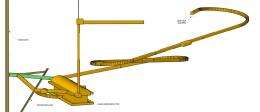March 27, 2012 report
Budget cuts portend new direction for Fermilab's Long-Baseline Neutrino Experiment

(PhysOrg.com) -- Physicists working at Fermilab, the premier particle physics lab in the United States, have been asked to rework their plans for the Long-Baseline Neutrino Experiment (LBNE) in light of current and expected budget cuts. The request came from William Brinkman, director of the Department of Energy’s Office of Science, which was to provide over a billion dollars in funding for the experiment over the next several years. The director cited proposed cuts to the DOE’s budget by the White House and suggested that such cuts are likely to occur for the foreseeable future. Fermilab director Pier Oddone has responded by posting comments to the LBNE page insisting that the lab will remain committed to achieving its original goals but will need to find another way to reach them.
The plan for the LBNE was to shoot a beam of high intensity neutrinos a mile underground from the Fermilab facility outside of Chicago, to a detector in an abandoned (Homestake) gold mine in South Dakota. Specifically, the idea was to shoot one type of neutrino, muon (the other two are electron and tau), from the site and then measure how much of that one type was converted or oscillated to the two other types during the journey. Such oscillations, it is believed occur due to interference in their mass states. By measuring such oscillations, new information could be garnered regarding mixing angles, which could in the end, help explain why there is so much more matter than antimatter in the known universe.

Oddone was careful in his postings to note that the project itself is not under threat of cancellation, it’s more that the DOE is unable to fund the project in its current configuration. This leaves the lab with three basic options as it tries to stretch out the time line of the LBNE, phasing it in, rather than going whole hog. The first would be to build the detector in the Homestake mine first, and then use it to study cosmic rays while waiting for the neutrino beam to come online from near Chicago. A second approach would be to build the facility for creating the beam first, and use it to study the interactions between electrons and neutrinos until the detector could be built. The third option, which no one would like, would be to abandon the idea of shooting the neutrinos through the Earth and build the detector on a ground site instead, a choice that would allow for a high amount of background noise.
The project is scheduled to undergo a review sometime next week, where all of the available options will be discussed and a future direction likely planned.
More information: lbne.fnal.gov/
© 2012 PhysOrg.com



















